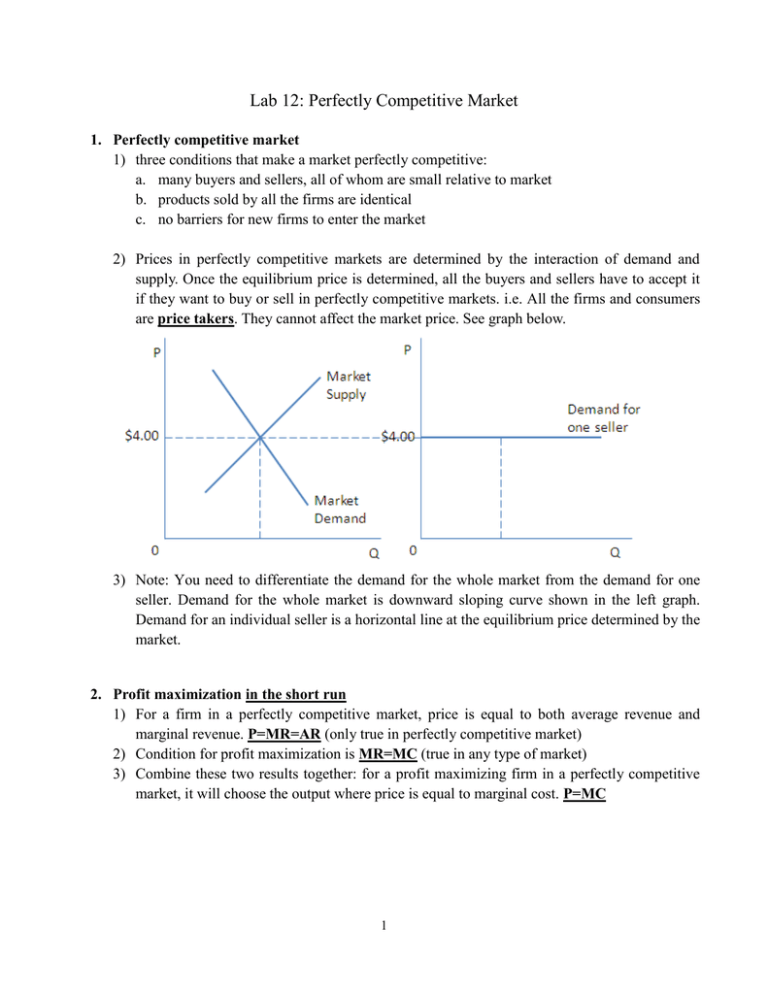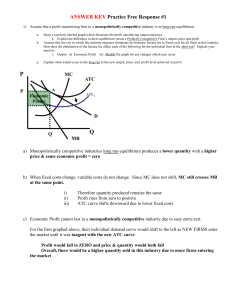Lab 12: Perfectly Competitive Market
advertisement

Lab 12: Perfectly Competitive Market 1. Perfectly competitive market 1) three conditions that make a market perfectly competitive: a. many buyers and sellers, all of whom are small relative to market b. products sold by all the firms are identical c. no barriers for new firms to enter the market 2) Prices in perfectly competitive markets are determined by the interaction of demand and supply. Once the equilibrium price is determined, all the buyers and sellers have to accept it if they want to buy or sell in perfectly competitive markets. i.e. All the firms and consumers are price takers. They cannot affect the market price. See graph below. 3) Note: You need to differentiate the demand for the whole market from the demand for one seller. Demand for the whole market is downward sloping curve shown in the left graph. Demand for an individual seller is a horizontal line at the equilibrium price determined by the market. 2. Profit maximization in the short run 1) For a firm in a perfectly competitive market, price is equal to both average revenue and marginal revenue. P=MR=AR (only true in perfectly competitive market) 2) Condition for profit maximization is MR=MC (true in any type of market) 3) Combine these two results together: for a profit maximizing firm in a perfectly competitive market, it will choose the output where price is equal to marginal cost. P=MC 1 3. Show the profit or loss on the graph How to calculate the profit: Total Profit=TR-TC =P*Q-ATC*Q = (P-ATC)*Q Profit per unit of output=Total profit/Q =P-ATC Look at the graph above, firm should choose to produce output Q to maximize profit since Q is the output level at which point P=MC. The shaded area is total profit for this profit-maximizing firm. The vertical distance between point A and B = (P-ATC), which is profit per unit of output. The profits of firm have three possibilities: 1) P> ATC, firm makes a profit, this case is shown in the above graph. 2) P< ATC, firm experience losses, see right graph below, total loss is the shaded area. 3) P=ATC, firm breaks even (profit=0), see left graph, point A is called the break-even point (the minimum point of ATC curve). 2 4. Shut down point in the short run When a firm suffers from losses in the short run (P<ATC), it has two choices: 1) Continue to run the firm: Loss1= (P-ATC)*Q 2) Stop production by shutting down temporarily. Under this choice, firm still need to pay its fixed cost since fixed cost is kind of sunk cost in the short run. Therefore, Loss2= -FC= -AFC*Q So, whether the firm who suffering losses chooses to shut down in the short run depends on the magnitudes of the two losses: 1) If P> AVC, Loss1>Loss2, firm should continue to run the business although it experiences losses in the short run. 2) If P< AVC, Loss1<Loss 2, firm should choose to shut down in the short run. 3) If P=AVC, Loss1=Loss 2, firm should be indifferent between still running the firm or shut it down. Note: To determine whether a firm makes profit, you compare P and ATC To determine whether a firm should shut down its business (you already know that P<ATC), you compare P and AVC 5. The supply curve of a firm in the short run 1) Supply is 0 when actual price is smaller than shut down price (price of the minimum point of AVC) 2) Supply curve is equal to MC curve when actual price is greater than shut down price 3) When actual price is equal to shut down price, firm is indifferent providing any output between zero and Q 3 6. Firm’s choices in the long run a. Economic profit leads to entry of new firms: b. Economic Losses lead to exit of existing firms: See figure 11-9 in textbook Page396 c. Due to entry and exit, the long-run equilibrium market price is at the level equal to the minimum point of firm’s ATC curve. See graph below. All the firms in a perfectly competitive market earn economic profit equal to zero. (Since economic profit is the profit after accounting for the implicit cost of a firm, zero economic profit means positive accounting profit. This is why firms earning zero economic profit still exist in the market.) d. Long run supply curve—a horizontal line at the price determined by the minimum point of ATC curve. e. Shutdown point and break-even point are the same in the long run: the minimum point of ATC curve (compare to the shutdown point in the short run: the minimum point of AVC curve) 4 Exercise: 1. (4.4 Page 407) The graph represents the situation of a perfectly competitive firm. Indicate on the graph the areas that represent the following: a. Total cost=ATC*Q b. Total revenue=P*Q c. Variable cost=AVC*Q d. Profit or loss=(P-ATC)*Q Briefly explain whether the firm will continue to produce in the short run. Answer: The firm should continue to produce in the short run. That’s because that when firm produce the output level where MR=MC (output level Q), price is greater than average variable cost. The loss from continuing the business is lower than the loss from totally shutting down. 2. (3.6 page 406) According to a report in the Wall Street Journal, during the fourth quarter of 2003, the profits of British Airways rose to £83 million, from £13 million one year earlier. At the same time, “the average amount the airline makes on each paying passenger fell 0.8%.” If profit per passenger fell, how could total profits rise? Illustrate your answer with a graph. Be sure to indicate profit per passenger and total profit on the graph. Answer: Total profit can rise, even if profit per passenger falls, if the total number of passengers rises. The graph is drawn so that price stays the same, while the firm increases the scale of its operations, as shown by the move from ATC1 to ATC2. The average total cost per passenger is now slightly higher, shrinking profit per passenger-but the quantity has risen significantly, so total profits have risen, from (P-ATC1)*Q1 to (P-ATC2)*Q2. 5 3. Suppose that in the short run, a profit-maximizing firm in a perfectly competitive market produces a quantity such that ATC>P=MC>AVC. We may conclude that: A. The firm will earn a normal profit, and investors will receive the normal rate of return B. Total revenue (TR) is less than total variable cost (VC) and the firm must shut down in the short run C. If the condition persists, some firms will leave the market in the long run D. If the condition persists, new firms will be attracted to this market in the long run. Answer: C Let’s look at the choice one by one. Choice A is wrong since when P<ATC, the firm is losing money Choice B is wrong because in this question TR is greater than VC. We can see this by multiply Q on both sides of P>AVC. Choice C is right and Choice D is wrong because when P<ATC, the firm is losing money, which will cause some firms in the industry to leave the market in the long run. 6







